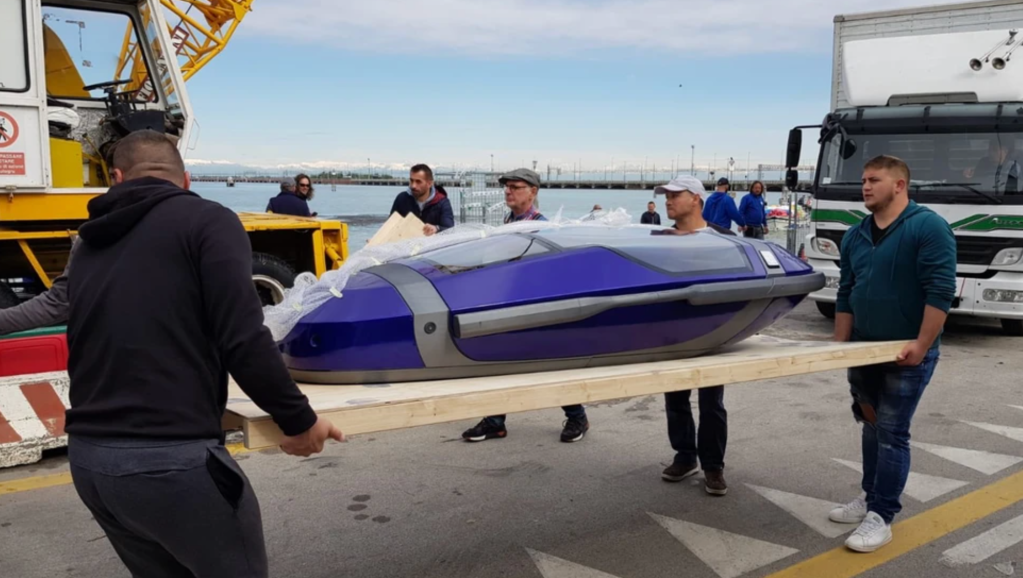Go into any serious gun owner’s home and you’ll find firearms fixed above mantelpieces, hung in display cases, or resting inside ornate gun cabinets. Despite the violence often associated with owning a gun collection, there’s something vaguely artistic about their presentation—something sculptural.
For her latest work, artist Addie Wagenknecht, who in the past has worked with WIFI sculptures, drone paintings, and golden CCTV cameras, takes this tendency to its fetishistic conclusion. Instead of choosing a Remington shotgun, however, Wagenknecht opted to 3D-print 13 “Liberator” pistols, then assemble them into a striking sculpture that is equal parts futuristic, menacing, and comically absurd.
Videos by VICE

Addie Wagenknecht, Liberator Rounds, 2015. Courtesy the artist and bitforms gallery. Image credit Mario Gallucci, courtesy of Upfor Gallery
The work, known as Liberator Rounds, will appear as part of the upcoming Eyebeam In Objects exhibition at Portland’s Upfor Gallery from September 3 to October 10. The Liberator itself was the first 3D-printed “open source” gun that got any significant mainstream attention (watch Motherboard’s stellar documentary on the Liberator, Click, Print, Gun, here). Wagenknecht simply pulled its torrent file off of the internet, and picked the version based on the file with the most seeds.
“I didn’t have a 3D printer so I had a friend print them for me in Germany,” Wagenknecht explains. “The guns took about 18 days of printer time with the printer running about 24 hours a day.”

Addie Wagenknecht, Liberator Rounds, 2015, courtesy the artist and bitforms gallery. Image credit Mario Gallucci, courtesy of Upfor Gallery
Once printed, Wagenknecht assembled the parts. She found the texture of a low-resolution 3D print to be part of the aesthetic, so she chose not to paint or sand down the prints. The decision works well: the chandelier has the feel of a technology and an open-sourced culture in its earliest, Wild-West days.

Addie Wagenknecht, Liberator Rounds, 2015, courtesy the artist and bitforms gallery. Image credit Mario Gallucci, courtesy of Upfor Gallery
And this isn’t the first time Wagenknecht has used the chandelier form for a sculpture. In 2013, she unveiled Asymmetric Love Number 2, a chandelier made out of CCTV surveillance cameras, steel and DSL internet cables. Wagenknecht tells The Creators Project that she returned to this sculptural form because she wanted to draw a parallel between objects found in abundance in our current culture.
“Addie’s work is firmly rooted in a tradition of media works that are meant to disrupt,” Eyebeam Director Roddy Shrock tells The Creators Project. “Not in any tech-utopic Silicon Valley meaning of the word but with a visceral and abrupt snap that attempts to dislodge magical thinking around notions of progress. Eyebeam has a long history of supporting work of this type, from that of Graffiti Research Lab up to Addie’s participation in Deep Lab, a feminist hackers collective.”

Addie Wagenknecht, Liberator Rounds, 2015,
courtesy the artist and bitforms gallery. Image credit Mario Gallucci, courtesy of Upfor Gallery
ceiling mounted 3D printed liberators on custom metal body, 4.25 x 6.25 x 16 in / 10.8 x 15.9 x 40.6 cm,
“The series is about ubiquitous objects in our environment and a shift in contemporary context, the playful and subversive quality of surveillance and data culture in our everyday environments,” says Wagenknecht. “The work plays with the underlying notion of how culture is produced and distributed—how they have been affected by our disenchantment and simultaneous obsession [with] digital culture.”

Addie Wagenknecht, Liberator Rounds, 2015, courtesy the artist and bitforms gallery. Image credit Mario Gallucci, courtesy of Upfor Gallery
Wagenknecht chose the 3D-printed gun because she wanted to explore the implications of technology within creative social applications. It is, for her, a work that was enabled by the internet’s endless potential for creating many worlds.
“The net has made it possible to share and express culture in ways that were never possible before,” she explains. “In that sense, Pirate Bay is one of the most successful works of our time.”

Addie Wagenknecht, Liberator Rounds, 2015, courtesy the artist and bitforms gallery. Image credit Mario Gallucci, courtesy of Upfor Gallery
“I am a generation that grew up between two paradoxes: the anonymity of 20 years ago and the intense surveillance that has shifted the paradigm of online culture to where we are now,” she adds. “We trust corporations more than each other [and] 3D guns are simply a byproduct of this.”
Click here for more from Addie Wagenknecht.
Related:
Artists Turn Songs into 3D-Printed Sculptures
3D-Printed Mistakes Are Inspiring a New Kind of Glitch Art
Help an Artist Recreate a Legendary Sculpture Using 3D Printing



